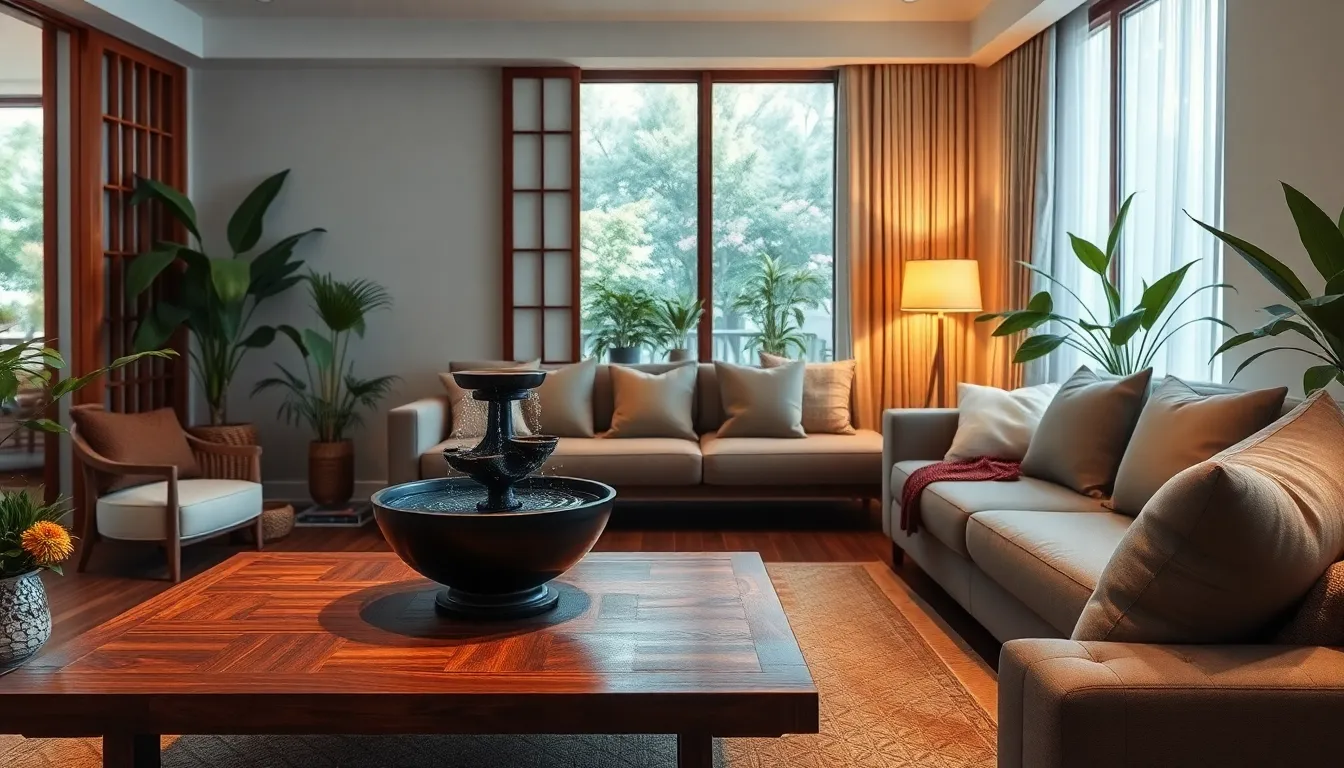Feng Shui design is more than just an aesthetic choice; it’s a powerful practice rooted in ancient Chinese philosophy. By harmonizing individuals with their environment, this art form aims to create spaces that promote balance, energy flow, and well-being. As people seek refuge from the chaos of modern life, the principles of Feng Shui offer a refreshing approach to interior design.
Incorporating Feng Shui into home and office spaces can transform the atmosphere, enhancing productivity and fostering tranquility. Whether it’s positioning furniture for optimal energy flow or choosing colors that evoke specific emotions, understanding these concepts can lead to a more fulfilling and harmonious living experience. Embracing Feng Shui design not only enriches spaces but also nurtures the soul.
What Is Feng Shui Design?
Feng Shui design encompasses principles from ancient Chinese philosophy that focus on harmonizing individuals with their environments. This practice promotes balanced energy, known as “Chi,” flowing through spaces. Feng Shui aims to create an atmosphere that enhances overall well-being, tranquility, and productivity.
Key elements of Feng Shui design include:
- Placement: Furniture arrangement influences energy flow. Optimizing placement creates a smooth circulation of Chi, enhancing comfort and functionality in a space.
- Color: Color selection impacts mood and energy. Warm colors encourage excitement, while cool colors promote calmness. Harmonizing these colors can foster balance.
- Natural Elements: Incorporating elements like water, wood, and plants connects spaces to nature, enhancing the flow of Chi. These elements bring vitality and foster a serene ambiance.
- Clutter Management: Minimizing clutter removes obstacles to energy flow. A decluttered space supports clarity and focus, optimizing the overall atmosphere.
Understanding these fundamental aspects helps individuals create spaces that nurture the soul and enhance their daily experiences. Integrating Feng Shui principles can transform homes and offices into sanctuaries of peace and productivity.
Key Principles of Feng Shui Design

Feng Shui design relies on specific principles that guide the arrangement of spaces, promoting harmony and positive energy. Understanding these key principles enhances the effectiveness of Feng Shui practices.
The Five Elements
The Five Elements—Wood, Fire, Earth, Metal, and Water—represent different energies and play a crucial role in Feng Shui. Each element corresponds to specific qualities:
- Wood promotes growth and vitality, associated with health and family.
- Fire symbolizes passion and energy, enhancing clarity and decision-making.
- Earth fosters stability and nourishment, providing grounding and support.
- Metal represents precision and focus, aiding in clarity and efficiency.
- Water embodies flow and adaptability, enhancing communication and abundance.
Balancing these elements within a space ensures a harmonious environment that nurtures well-being.
Yin and Yang
Yin and Yang represent dual forces that coexist in balance. Yin symbolizes softness, passivity, and introspection, while Yang embodies strength, activity, and energy. Achieving harmony between these forces is vital in Feng Shui design.
- Uniformity across different areas promotes a balanced atmosphere.
- Contrast between light and dark elements creates dynamism.
- Complementary elements enhance overall peace and productivity.
Creating spaces that respect these dynamics supports mental and emotional clarity.
The Bagua Map
The Bagua Map serves as a blueprint for Feng Shui, identifying different areas of life represented in specific zones of a space. Each section corresponds to aspects such as career, relationships, and health. Utilizing the Bagua Map involves:
- Aligning areas of the map with rooms or sections of a space.
- Enhancing specific sections using corresponding colors, shapes, and elements.
- Focusing energy on important life aspects to promote personal and professional growth.
Correctly applying the Bagua Map fosters a supportive environment aligned with individual goals and aspirations.
Benefits of Feng Shui Design
Feng Shui design offers multiple benefits that enhance both physical spaces and individual well-being. By applying Feng Shui principles, one can create environments that promote positive energy and improve overall quality of life.
Enhancing Well-Being
Feng Shui design enhances well-being by optimizing energy flow within spaces. Proper furniture arrangement encourages the circulation of Chi, or life energy, promoting physical health and mental clarity. Greenery, a crucial component, connects individuals to nature, fostering tranquility and reducing stress. Thoughtful color choices can uplift mood and stimulate creativity, while decluttering minimizes distractions, supporting focus and mental clarity.
Promoting Harmony
Feng Shui design promotes harmony by balancing Yin and Yang energies within a space. This balance fosters peace and stability, positively impacting relationships and interactions among occupants. Utilizing the Five Elements—Wood, Fire, Earth, Metal, and Water—ensures that spaces embody diverse qualities that contribute to a harmonious atmosphere. The Bagua Map aligns different life areas with specific zones, thereby enhancing life aspects such as career, health, and relationships, leading to a more fulfilling and balanced existence.
Common Mistakes in Feng Shui Design
Feng Shui design often encounters common pitfalls that can disrupt the intended harmony and balance of a space. Identifying and addressing these mistakes can significantly enhance energy flow and overall well-being.
Ignoring the Layout
Ignoring the layout of a space can lead to stagnation of energy, known as Chi. Disregarding this can result in awkward furniture placement that blocks pathways and creates chaos. It’s crucial to consider the flow of movement within a room. Ensuring clear pathways promotes better circulation of energy, fostering a sense of calm and focus. Pay attention to the arrangement of furniture, aligning pieces to support both functionality and aesthetic appeal.
Cluttering Spaces
Cluttering spaces creates negative energy, obstructing the flow of Chi and contributing to feelings of overwhelm. Excess items can weigh down the environment, hindering clarity and productivity. Regularly decluttering spaces involves removing unnecessary objects, organizing belongings, and maintaining a clean atmosphere. Implementing storage solutions helps keep areas tidy and promotes a sense of openness, essential for positive energy flow in Feng Shui design.
Practical Tips for Implementing Feng Shui Design
Implementing Feng Shui design involves strategic choices and thoughtful arrangements to create harmonious spaces. These practical tips focus on selecting colors and materials, as well as arranging furniture effectively.
Choosing Colors and Materials
Choosing colors and materials impacts mood and energy flow significantly.
- Select calming colors like blues and greens to enhance tranquility and relaxation.
- Incorporate warm colors such as reds and oranges to stimulate creativity and energy.
- Use natural materials like wood and stone to foster a connection with nature, promoting grounding and stability.
- Avoid harsh or overly bright colors that can create discomfort and unease in living spaces.
- Consider the Five Elements when selecting colors: Wood (green), Fire (red), Earth (yellow), Metal (white), and Water (blue) to bring balance and positive energy.
Arranging Furniture
Arranging furniture strategically optimizes energy flow and creates functional spaces.
- Position furniture thoughtfully to maintain clear pathways, allowing Chi to circulate freely.
- Avoid placing furniture directly in line with doors, which can block energy and create feelings of discomfort.
- Ensure seating arrangements promote conversation, like circular or U-shaped layouts, to enhance connection and interaction among occupants.
- Use mirrors wisely to reflect light and expand space, but avoid placing them directly facing the bed or seating areas, as this can cause restlessness.
- Prioritize balance by distributing furniture evenly throughout the room, preventing any area from feeling overcrowded or sparse.
Implementing these practical tips fosters a harmonious environment, enhancing well-being and productivity.
Feng Shui design offers a powerful approach to creating balanced and harmonious spaces. By understanding and applying its principles, individuals can enhance their environments and well-being. Thoughtful furniture arrangement, mindful color choices, and the incorporation of natural elements all contribute to a positive energy flow.
Implementing these strategies not only promotes tranquility but also fosters productivity and clarity. Regular decluttering and maintaining open pathways ensure that Chi circulates freely, enhancing the overall atmosphere. Embracing Feng Shui can transform any space into a sanctuary that nurtures the soul and supports personal growth. It’s a journey toward creating a more fulfilling life through intentional design.





